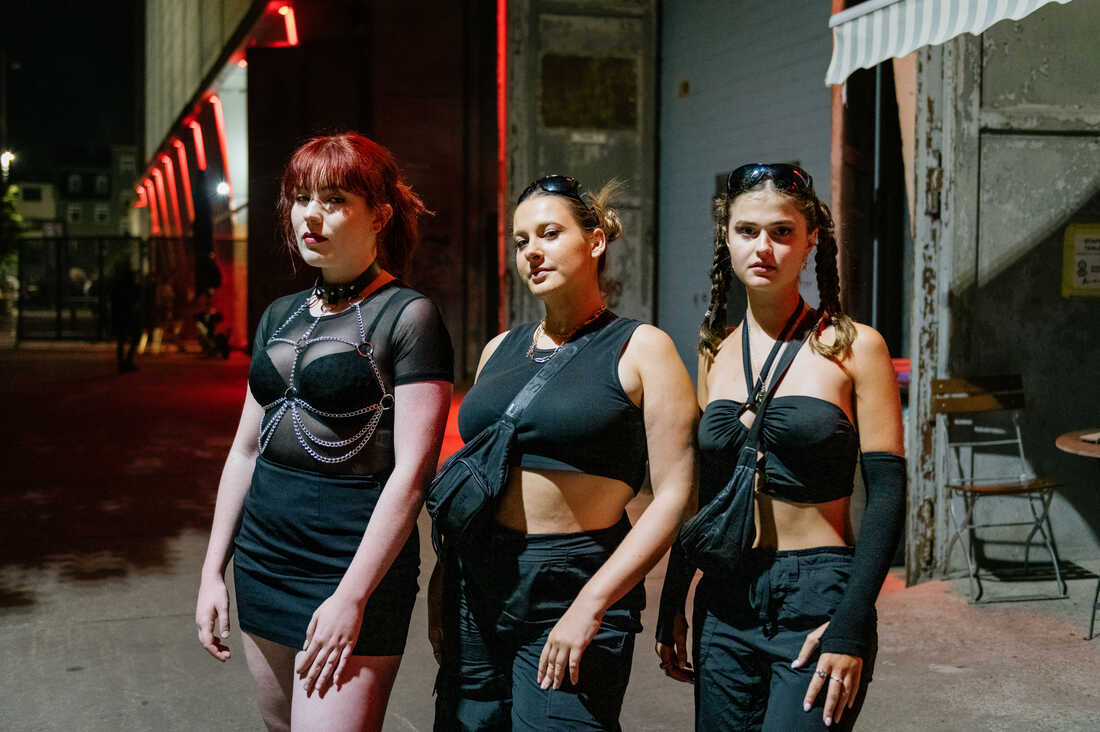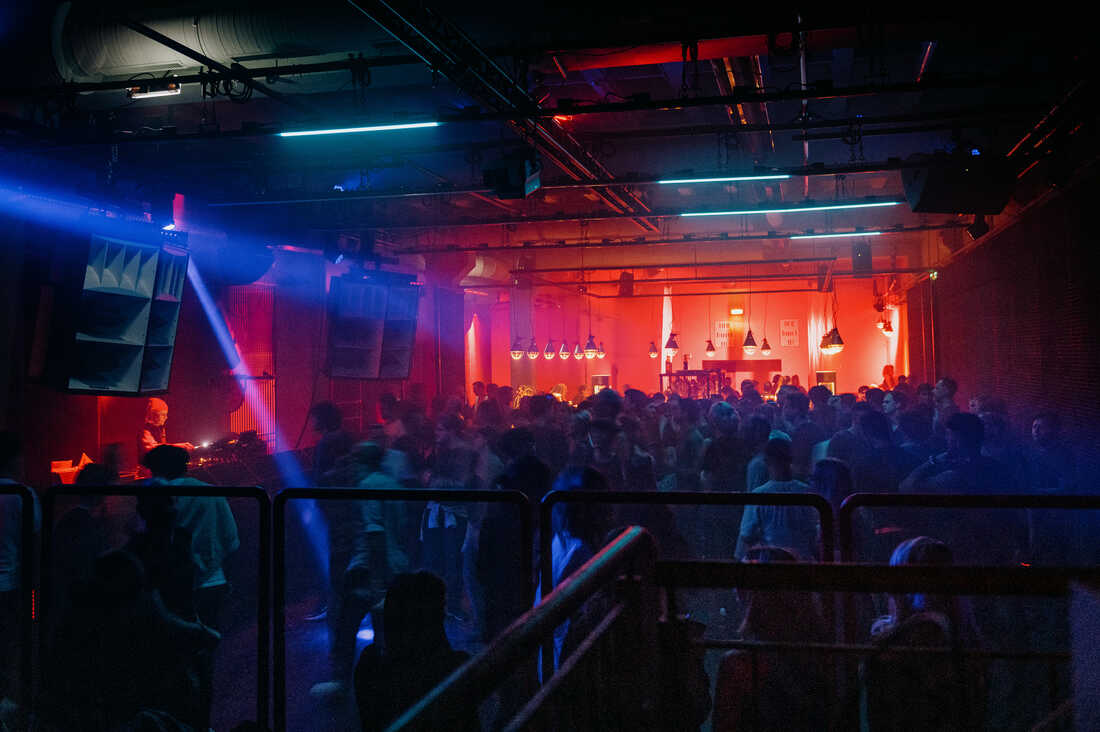
From left to right: Philippa, 23, from Sydney, Australia; Laura, 23, from Melbourne; and Isabella, 23, from Sydney, lined up on the morning of September 4 to enter Tresor Berlin, one of Germany's most popular electronic music clubs. Hide Jacobia Dahm for text that says NPR
BERLIN, Germany - On Sunday morning, hundreds of people, mostly dressed in black, lined up outside Berghain, Berlin's almost mythical techno club with a door.
Among those hoping to attend is Chris Kastlin, a photographer from Berlin who visits the club at least once a month. When Berlin's bars and clubs closed for the first time in 70 years during the pandemic, the fabric of the city was torn apart, he said.
“For a lot of people, especially in Berlin, going to a club doesn't mean, 'Oh, I want to go to a party. I want to get drunk," he says. "It's more of a lifestyle, more of a hobby, going out and dancing and interacting with people."

Tresor, one of Berlin's most traditional clubs, is housed in a former power station building and has three dance floors with a capacity of 1,500 people. Hide Jacobia Dahm for text that says NPR
A key factor in the Berlin scene: the club doesn't have to close its doors. Many are open all weekend, so some ravers arrive on Friday night and leave on Sunday morning.
Borderless Berlin's cultural roots can be traced back to the beginning of the Cold War, when the Whiskey Bottle Talks led to the abolition of borders in the post-war period and laid the foundation for Berlin to become one of the nations of the world. . the most popular place for techno music.
The whiskey encounter that changed everything
After World War II, divided Berlin imposed strict nighttime curfews, much to the dismay of residents, especially those looking for deals.
In 1949, not much was missing.
"Four years later, people want to walk again, go out. People want to drink," he said Dimitri Hegemann, founder and owner of Tresor, one of the most traditional clubs in Berlin.

68-year-old Dimitriy Hegeman, founder and owner of Tresor, on August 31 in the center, where today, in addition to the central club, exhibitions and cultural events are held. Hide Jacobia Dahm for text that says NPR
In unionized West Berlin, bars close at 9:00 p.m. In the Soviet-controlled east, closing time is 10 p.m
West Berlin is tired of the East taking these dollars at the last minute and sending them back an hour later. In response, Timur left for another hour. It became something good for dad.
A guest named Heinz Zellermeier was enough. He took a bottle of whiskey and handed the trunk to Brigadier General Frank Gawley, the American sector commander in West Berlin.
According to a family biography by Ilsa's sister Eliza Zellermeier, Zellermeier allegedly said, "They need curfew as much as we need our favorite bread."
"It's just chaos when the bartender has to say 'closing time,'" the hotel owner said.
Zellermeier argued that the removal of borders is good for the economy and that unlimited freedom is an expression of Western values.
Gawli was just as convinced as his French counterpart.
However, this tone was rejected by the British, who were concerned that the pub's patrons would become too loud.
No problem. In June 1949, the closure of West Berlin was finally lifted with a score of 2:1.
Zellermeier was quick to share the news.
"After 10 minutes he called all the bars. And since that day, Berlin enjoys a youth night every day," Hegemann said. After the fall of the Berlin Wall, the former East Berlin embraced the borders of the West.

Long lines in front of the popular Berlin club KitKatClub on September 3. Köpenicker Strasse in Kreuzberg is home to two of the city's most popular clubs, KitKatClub and Tresor, and on many weekends the two lines meet. Hide Jacobia Dahm for text that says NPR
"History doesn't tell us how much whiskey was actually drunk," says the report of the Berlin Club's commission on the historic event, "but in the decades afterward, Berlin began to embrace the myth of the city that never sleeps." "
Berlin without borders attracts "techno-tourists" and their money
Zellermeier, who died in 2011, is now a popular hero among Berlin club owners.
Hegemann, the owner of the distillery, organized the event in honor of his famous whiskey meeting. Some describe Zellermeier as the "supermaster" of Berlin's bars and clubs.
But others say Zellermeier didn't get the credit he deserved for the 1949 talks.
"What it meant to the city as an attraction for him and for the city is not really appreciated today," said Knut Hofmeister, a Berlin-based filmmaker who has studied this part of German history.
Hofmeister previously edited the Global Hangover Guide , a publication on alcohol consumption. In 1999, to celebrate the 50th anniversary of the meeting that closed the Berlin border, he arranged for a limousine to pick up Zellermeier. Before entering, Hofmeister handed him a bottle of champagne. He then took Zellermeier to the Brandenburg Gate and took a picture of him with the celebratory half-century mark before it closed.

Heinz Zellermeier in front of the Brandenburg Gate in 1999 on the occasion of the 50th anniversary of the meeting to end the border in Berlin. Knut Hofmeister Hide text
"It gave people their night back," Hofmeister said. "It was a completely revolutionary act."
It is also the act that launched the city's powerful economic engine.
Other cities, of course, have clubs or underground scenes that dive late into the night where they are almost useless. But Ben Gu, a cultural scientist at the University of Melbourne who studies Berlin's techno scene, said the law that allows clubs to never close has long been what makes Berlin special.

Isabelle and Maura leave Tresor (left) around 06:15 on September 4, while Karam enters the famous Berlin nightclub (right). Hide Jacobia Dahm for text that says NPR
"I know people have tried in other cities, but they're always frustrated with liquor licensing and other regulations like that," he said. "So it's special in Berlin."
According to the commission of the Berlin Club, the so-called technological tourism annually attracts more than 3 million people to the city. According to a recent trade association survey, city clubbers spend around €1.4 billion a year in the city, excluding accommodation, food and transport, or around 8% of annual tourism spending.
City tourism officials say the city knows no bounds to attract visitors.
"Party until the sun comes up and then goes down again! Unlike other German cities, Berlin has no official closing time," according to the city's VisitBerlin website.

People line up to enter the vault at 1:30 a.m. (left) and 6:45 a.m. (right) on September 4. Jacoby Dahm for NPR hides the text
This club offers relaxation and inspiration to those lucky enough to be a part of it
Tresor just celebrated its 31st anniversary. The club is dark and spacious in an old power station. Smoke from cigarettes and smoke machines. Most DJs play loud techno music while keeping partygoers in the spotlight as they enjoy smooth, deafening beats.
At Tresor and other venues like Berghain and KitKatClub, revelers don sunglasses to the beat of the music. Sometimes that's all they wear.
Before letting people in, the security guards put a sticker on the cell phone camera. Everything that happens in a club, whether it's a dance marathon, sex or drug use, should be in a club. Privacy is paramount.
Hegemann, the owner of Tresor, says the club is not just about hedonism and escapism, but about incubating ideas.
When people take a break to dance and relax elsewhere, creative collaborations and business ideas emerge, he says. He believed that this was due to the lack of city boundaries.
"The best ideas come after 3:30 in the morning," he says. "People are coming together, we're coming together and saying, 'Hey, we want to join this movement.' Let's do something. Maybe tomorrow we will open a gallery or a cafe."

Inside the venue, in the building that houses the Tresor disco and exhibition space, on August 31. The club is located in the building of the old power station. Hide Jacobia Dahm for text that says NPR
"That's why I think techno is changing Berlin, changing Europe, changing the world," he said.
Photographer Kostlin says that at Berghain, where there are endless lines of hopefuls waiting outside, tourists often read too much online about what it takes to get into the club, causing them to reconsider and black out.
"It's not about the clothes, but people think so," Koestlin said.
Most clubs in Berlin don't keep everyone in line, but at Berghain trying to understand the esoteric door policy is like trying to navigate a Greek labyrinth. There may be many failed attempts before someone logs in.
" Unfortunately, not today ," several guards said to those who refused, which basically meant "Today is not your day."
The trip to Berghain can take five hours or more on weekends. There's also an Instagram page with 48,000 followers dedicated to weekend updates.
Upon arriving at the entrance, whoever is working the door will do a quick assessment based on a "subjective" assessment, the security guard above told GQ .
“But you always want friction. That's the motto of any good club: diversity, exhaustion," Sven Marquardt told the magazine in 2015 in a rare interview.
But the city's lack of restrictions allows for multiple weekend rehearsals, Kestlin said.
"They're always rolling the dice," Kestlin said. “You have to be yourself and be authentic. If it looks like you're only dressed for entry, they can smell it. But when you log in, there is no time limit. This is absolute freedom. And that's what I like."

(From left to right, top) Katarina, 26, Klara, 23, Christina, 26, and (left, bottom) Peter, 30, and Aurelia, 23, line up at Tresor in Berlin on September 4. Hide subtitles Jacoby Dam for NPR


Post a Comment